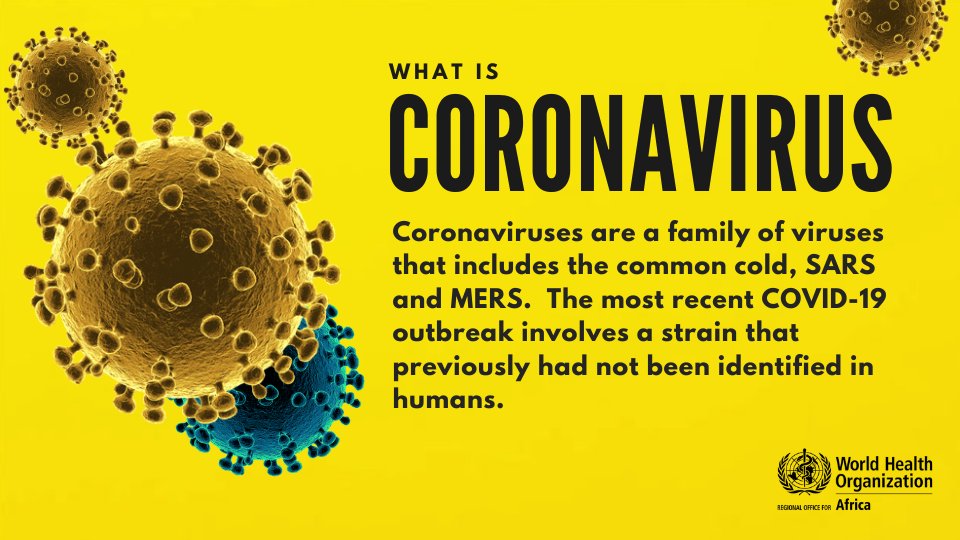What it’s like contract Coronavirus

A World Health Organisation (WHO) official on Thursday warned that African countries could be hit harder by the new Coronavirus when winter arrives later this year.
What is Coronaviruses (CoV) are a large family of viruses that cause illness ranging from the common cold to more severe diseases such as Middle East Respiratory Syndrome (MERS-CoV) and Severe Acute Respiratory Syndrome (SARS-CoV) but Coronavirus disease (COVID-19) is a new strain that was discovered in 2019 and has not been previously identified in humans.
Twitter blocks accounts of Venezuelan vice-president who deals with combating covid-19
According to Dr Maria Van Kerkhove, who heads the WHO’s Health Emergencies Programme he said Coronavirus disease (COVID-19) multiplies in the respiratory tract and can cause a range of symptoms, such as mild cases of the common cold, which have some respiratory symptoms, sore throat, runny nose, fever, all the way through pneumonia. And there can be varying levels of severity of pneumonia all the way through multi-organ failure and death,”
The first symptom of COVID-19 is usually a fever.
Then come respiratory symptoms, like a dry cough and shortness of breath, that often turn into pneumonia.
The worst cases often lead to respiratory failure, which could result in death.
Basic protective measures against the new coronavirus
Stay aware of the latest information on the COVID-19 outbreak, available on the WHO website and through your national and local public health authority. Most people who become infected experience mild illness and recover, but it can be more severe for others. Take care of your health and protect others by doing the following:
Wash your hands frequently
Regularly and thoroughly clean your hands with an alcohol-based hand rub or wash them with soap and water.
Why? Washing your hands with soap and water or using alcohol-based hand rub kills viruses that may be on your hands.
Maintain social distancing
Maintain at least 1 metre (3 feet) distance between yourself and anyone who is coughing or sneezing.
Why? When someone coughs or sneezes they spray small liquid droplets from their nose or mouth which may contain virus. If you are too close, you can breathe in the droplets, including the COVID-19 virus if the person coughing has the disease.
Avoid touching eyes, nose and mouth
Why? Hands touch many surfaces and can pick up viruses. Once contaminated, hands can transfer the virus to your eyes, nose or mouth. From there, the virus can enter your body and can make you sick.
Practice respiratory hygiene
Make sure you, and the people around you, follow good respiratory hygiene. This means covering your mouth and nose with your bent elbow or tissue when you cough or sneeze. Then dispose of the used tissue immediately.
Why? Droplets spread virus. By following good respiratory hygiene you protect the people around you from viruses such as cold, flu and COVID-19.
If you have fever, cough and difficulty breathing, seek medical care early
Stay home if you feel unwell. If you have a fever, cough and difficulty breathing, seek medical attention and call in advance. Follow the directions of your local health authority.

Why? National and local authorities will have the most up to date information on the situation in your area. Calling in advance will allow your health care provider to quickly direct you to the right health facility. This will also protect you and help prevent spread of viruses and other infections.
Stay informed and follow advice given by your healthcare provider
Stay informed on the latest developments about COVID-19. Follow advice given by your healthcare provider, your national and local public health authority or your employer on how to protect yourself and others from COVID-19.
Why? National and local authorities will have the most up to date information on whether COVID-19 is spreading in your area. They are best placed to advise on what people in your area should be doing to protect themselves.
How dangerous is the new coronavirus?
Thought to have been transmitted to humans from an as-yet-unidentified animal source, the new virus spreads primarily through respiratory droplets, such as those generated when an infected person coughs or sneezes.
On average, it takes about five to six days for someone to show symptoms after becoming infected. However, some people who carry the virus remain asymptomatic, meaning they do not show any symptoms.
The virus multiplies in the respiratory tract and can cause a range of symptoms, according to Dr Maria Van Kerkhove, who heads the WHO’s Health Emergencies Programme.
“You have mild cases, which look like the common cold, which have some respiratory symptoms, sore throat, runny nose, fever, all the way through pneumonia. And there can be varying levels of severity of pneumonia all the way through multi-organ failure and death,” she told reporters in Geneva on February 7.
However, in most cases, symptoms have remained mild.
“We’ve seen some data on about 17,000 cases and, overall, 82 percent of those are mild, 15 percent of those are severe and 3 percent of those are classified as critical,” said Van Kerkhove.
Fever, cough, pneumonia
A study of 138 patients infected with the new virus in Wuhan, published in the Journal of the American Medical Association (JAMA) on February 7, showed the most common symptoms were fever, fatigue and dry cough. A third of the patients also reported muscle pain and difficulty breathing, while about 10 percent had atypical symptoms, including diarrhoea and nausea.
The patients, who ranged in age from 22 to 92, were admitted to the Zhongnan Hospital of Wuhan University between January 1 and 28. “The median age of patients is between 49 and 56 years,” JAMA said. “Cases in children have been rare.”
While most cases appeared to be mild, all the patients developed pneumonia, according to JAMA.
About a third subsequently developed severe breathing difficulties, requiring treatment in the intensive care unit. The critically ill were older and had other underlying conditions such as diabetes and hypertension.
Six of the 138 patients died – a figure amounting to a 4.3-percent death rate, which is higher than estimates from other parts of China. Less than 2 percent of the total number of infected people have died from the virus so far but that figure could change.
Meanwhile, a study published on January 24 in The Lancet medical journal found what it called a “cytokine storm” in infected patients who were severely ill. A cytokine storm is a severe immune reaction in which the body produces immune cells and proteins that can destroy other organs.
Some experts say this could explain deaths in younger patients. Statistics from China show some people in their 30s, 40s and 50s, who were not known to have had prior medical issues, have also died from the disease.
A timeline of how the disease progresses
According to JAMA, on average, people became short of breath within five days of the onset of their symptoms. Severe breathing trouble was observed in about eight days.
The study did not give a timeline for when the deaths occurred.
However, an earlier study published in the Journal of Medical Virology on January 29 said that, on average, people who died did so within 14 days of the onset of the disease.
The New England Journal of Medicine, in a study published on January 31, also offered a look at how the coronavirus infection affects the body over time.
The study examined the medical data of a 35-year-old man, the first case of infection in the United States. The first symptom was a dry cough, followed by a fever.
On the third day of illness, he reported nausea and vomiting followed by diarrhoea and abdominal discomfort on the sixth day. By the ninth day, he had developed pneumonia and reported difficulty breathing.
By the twelfth day, his condition had improved and his fever was subsiding. He developed a runny nose, however. On day 14, he was asymptomatic except for a mild cough.
According to local media reports, he sought care on January 19 and was discharged from the hospital in the first week of February.
Tedros Adhanom Ghebreyesus, WHO chief, told reporters on February 24 that statistics from China suggest recovery time for people with mild disease is about two weeks. People with severe or critical disease may take between three and six weeks to recover.








